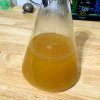Last batch I brewed I decided to make a starter because the yeast (Wyeast London Ale III) was almost 5 months after manufacture date. It turned out perfectly - I had it on the stir plate for approx. 14 hours, and then left it for another 36 hours and then refrigerated the night before brew day. The starter was super active...produced a lot of krausen etc.
My second go with a starter was yesterday evening - exact same process, volume, DME etc, but with Wyeast 1056 (American Ale). It's been off the stir plate now for about 8 hours, stored at about 19.5C, and although there's some activity, it seems barely there compared to my previous starter (see pic). Should I be concerned? If I don't see anything by tomorrow (brew day scheduled for Sunday) should I ditch it or pitch it?
My second go with a starter was yesterday evening - exact same process, volume, DME etc, but with Wyeast 1056 (American Ale). It's been off the stir plate now for about 8 hours, stored at about 19.5C, and although there's some activity, it seems barely there compared to my previous starter (see pic). Should I be concerned? If I don't see anything by tomorrow (brew day scheduled for Sunday) should I ditch it or pitch it?











![Craft A Brew - Safale S-04 Dry Yeast - Fermentis - English Ale Dry Yeast - For English and American Ales and Hard Apple Ciders - Ingredients for Home Brewing - Beer Making Supplies - [1 Pack]](https://m.media-amazon.com/images/I/41fVGNh6JfL._SL500_.jpg)






































